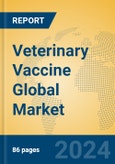Market Size and Growth Forecast
The global veterinary vaccine market is estimated to be valued between USD 8.5 billion and USD 9.5 billion in 2025, with a projected compound annual growth rate (CAGR) of 6% to 7.5% from 2025 to 2030, reaching approximately USD 12 billion to USD 14 billion by 2030.Regional Analysis
North America exhibits a growth rate of 5.5-7%, spearheaded by the U.S., where a robust pet culture and sophisticated livestock systems propel demand, with market trends favoring premium, technologically advanced vaccines tailored for companion animals and high-value herds. Europe grows at 5.5-7%, driven by Germany and France, where stringent animal health regulations and sustainable farming practices dominate, trending toward eco-friendly vaccines compliant with EU standards.Asia Pacific advances at 6.5-8%, led by China and India, where burgeoning swine and poultry industries fuel rapid adoption, with a shift toward affordable, locally manufactured vaccines to support massive agricultural output. The Middle East and Africa (MEA) grow at 5.0-6.5%, with South Africa focusing on livestock disease control, leaning toward cost-effective solutions to enhance food security. South America grows at 5.5-7%, with Brazil prioritizing swine and cattle vaccines, trending toward export-oriented disease management to meet global meat demand.
Application Analysis
Swine commands 30-35% of the market, growing at 6.5-8%, driven by intensive pork production and disease outbreaks, with trends leaning toward multi-strain vaccines to combat evolving pathogens. Poultry accounts for 25-30%, growing at 6.0-7.5%, emphasizing mass vaccination programs to protect against avian diseases, with advancements in delivery systems like spray and water administration. Cattle holds 20-25%, growing at 5.5-7%, focusing on herd immunity for diseases like bovine respiratory disease, with trends in long-lasting formulations.Sheep and goats represent 10-15%, growing at 5.0-6.5%, with regional disease control driving steady demand, trending toward combination vaccines. Pets account for 5-10%, growing at 6.0-7.5%, fueled by pet humanization, with trends in personalized and preventive vaccines. Others, including aquaculture, grow at 5.0-6.5%, with niche applications expanding gradually.
Key Market Players
- Zoetis: A U.S. powerhouse revolutionizing animal health with cutting-edge vaccine innovations.
- Boehringer Ingelheim: A German titan delivering sophisticated immunization solutions for diverse species.
- Merck & Co. Inc.: A U.S. leader enhancing disease prevention with versatile veterinary vaccines.
- Elanco: A U.S. maestro crafting robust vaccines to safeguard livestock and pets.
- Jinyu Bio-Technology Co. Ltd.: A Chinese innovator shaping affordable, high-impact vaccines for mass markets.
- Wuhan Keqian Biology Co. Ltd.: A Chinese expert advancing swine and poultry immunization technologies.
- Shanghai Shenlian Biomedical Co. Ltd.: A Chinese specialist delivering tailored vaccines for regional needs.
- Guangdong Yongshun Biopharmaceutical Co. Ltd.: A Chinese firm optimizing livestock health with scalable solutions.
- Shanghai Haili Biotechnology Co. Ltd.: A Chinese pioneer enhancing vaccine efficacy for broad applications.
- Zhengye Biotechnology Holding Limited: A Chinese visionary crafting next-generation animal health technologies.
Porter’s Five Forces Analysis
- Threat of New Entrants: Medium. The market’s high R&D costs, stringent regulatory requirements, and need for specialized expertise create significant barriers, yet growing demand and government support in emerging markets lower entry hurdles for established biotech firms, encouraging cautious expansion.
- Threat of Substitutes: Low to Medium. Alternatives like antibiotics and probiotics pose some competition, but vaccines’ superior preventive capabilities and alignment with antibiotic reduction policies maintain their dominance, though cost-sensitive regions may favor cheaper substitutes, necessitating focus on efficacy and value.
- Bargaining Power of Buyers: High. Large-scale farmers, cooperatives, and pet owners wield considerable influence, demanding cost-effective, high-efficacy vaccines and leveraging multiple suppliers to secure favorable pricing and terms, particularly in price-sensitive livestock sectors.
- Bargaining Power of Suppliers: Medium. Suppliers of biological raw materials and adjuvants hold moderate sway, but major players like Zoetis diversify sourcing and invest in in-house production, reducing dependency while stabilizing costs in a competitive supply chain.
- Competitive Rivalry: High. Leading firms vie intensely for market share through innovation in vaccine technology, pricing strategies, and geographic expansion, driving substantial investments in R&D and partnerships to address evolving disease threats and regulatory landscapes.
Market Opportunities and Challenges
Opportunities
- Rising meat consumption: Increasing global demand for pork, poultry, and beef drives vaccine adoption, aligning with food security trends and offering substantial growth in livestock-heavy regions like Asia Pacific and South America.
- Pet humanization: Growing pet ownership and spending on animal healthcare boost demand, tapping into premium markets in North America and Europe where owners seek advanced, personalized vaccines.
- Zoonotic disease prevention: Heightened awareness of diseases transmissible to humans enhances market appeal, opening avenues in public health initiatives and regulatory support for comprehensive vaccination programs worldwide.
- Emerging markets: Expanding agricultural and pet sectors in Asia Pacific and Africa fuel demand, leveraging scalable, cost-effective solutions to address unmet needs in developing economies.
Challenges
- Development costs: High R&D and production expenses limit affordability, posing barriers to penetration in price-sensitive markets where farmers prioritize cost over advanced technology, necessitating cost optimization strategies.
- Substitute competition: Antibiotics and alternative therapies threaten market share, requiring continuous differentiation through superior efficacy, safety profiles, and alignment with global antibiotic reduction mandates to maintain a competitive edge.
- Regulatory complexity: Diverse and evolving veterinary health standards across regions increase compliance costs, slowing market entry and demanding extensive adaptation to meet local requirements, particularly in Europe and North America.
- Supply chain disruptions: Tariff-induced trade barriers and raw material shortages risk delays, compelling firms to invest in localized production or absorb higher costs, testing operational flexibility in a volatile global trade environment.
This product will be delivered within 1-3 business days.
Table of Contents
Companies Mentioned
- Zoetis
- Boehringer Ingelheim
- Merck & Co. Inc.
- Elanco
- Jinyu Bio-Technology Co. Ltd.
- Wuhan Keqian Biology Co. Ltd.
- Shanghai Shenlian Biomedical Co. Ltd.
- Guangdong Yongshun Biopharmaceutical Co. Ltd.
- Shanghai Haili Biotechnology Co. Ltd.
- Zhengye Biotechnology Holding Limited








